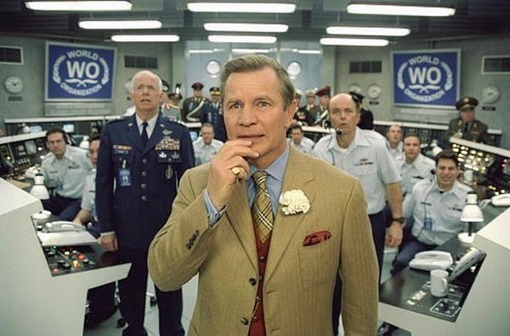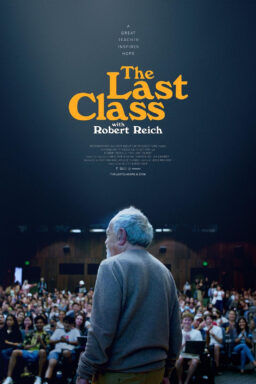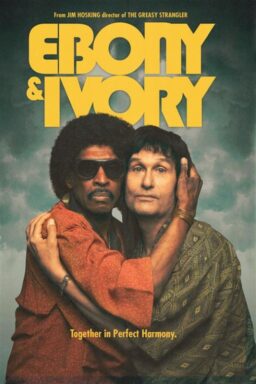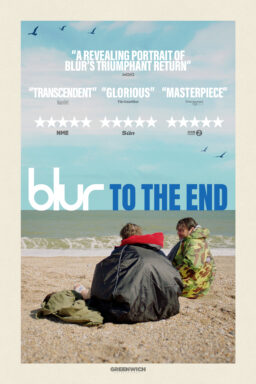Imagine a film in which all the characters are manifestations of a single consciousness, and the main way they communicate is by telling each other (and the movie audience) the story in which they, as characters, are participating — while they are actively in that story. In other words, what if the driving consciousness of the picture belonged to… Basil Exposition!?!? That’s my tongue-in-cheek take on a typically brilliant and enlightening shared dream post by Kristin Thompson and David Bordwell on “Inception” at Observations on Film Art.
KT says that the first time she saw Christopher Nolan‘s multi-leveled narrative she didn’t particularly enjoy it until about the last 36 minutes, when the van started falling into the water — the section that “marks the end of what we’ve called the Development portion of the film and the beginning of the Climax.”
At that turning point, it dawned on me that Nolan has elevated exposition of new premises to the main form of communication among characters. Discussion of their personal relationships, hopes, and doubts largely drops out. As the Russian Formalists would say, exposition, usually given early on and at wide intervals later in a plot, becomes the dominant here. That’s an unusual enough tactic to warrant a closer look.
And so it does. I urge you to join them. “Once I realized that this film’s plot concerns fiendishly complicated action that requires almost constant exposition from the characters, I enjoyed the rest of it,” KT writes. “I saw it a second time and enjoyed it even more. I certainly don’t understand the entire plot, and I suspect that’s partly because, despite the nearly constant revelation of premises, there were a few left out….”
In the meantime, I don’t see why we should get annoyed because ‘Inception’ doesn’t contain rich, fully rounded characters. It’s clearly a puzzle film that takes the usual complicated premises of a heist movie and pushes them to extremes. Accepting the flow of nearly continuous exposition may remove some of the frustrations viewers face. After all, there’s no rule against it.
Indeed, as DB says when he picks up the thread, those who (like me) didn’t actually enjoy the movie very much, might benefit from looking at it “inside-out.” He illuminates it from within:
The notion of motivation turns a lot of our usual thinking about cinema inside out. Usually we think that something is present in order to support what the film “says.” But actually a lot of what we find in films is motivated, either by genre or by appeal to realism, in order to give us a particular narrative experience.
For a couple of decades, some American cinema (both Hollywood and indie) has been launching some ambitious narrative experimentation. We’ve seen “puzzle films” (“Primer“), forking-path or alternative-future films (“Sliding Doors“), network narratives (“Babel,” “Crash“), and other sorts. This trend isn’t utterly new–there are earlier cases, especially in the 1940s–but it seems to have been accelerating in recent years, particularly after “Pulp Fiction” (1994). Christopher Nolan has participated in the trend as well, with “Following” and “Memento.”
DB cites a wealth of multiple, embedded or interwoven narratives across countries and film history: Griffith’s “Intolerance,” Welles’ “Citizen Kane,” Fellini’s “8 1/2,” Bunuel’s “That Obscure Object of Desire,” Wong’s “Chunking Express” and “Ashes of Time,” Tykwer’s “Run Lola Run,” among them — to which I would add Wojciech Has’s “The Saragossa Manuscript,” Tarsem’s “The Fall” and, yes, “The Princess Bride” — all threaded stories about storytelling.
The wrinkles Nolan adds, as DB sees it, are the ways in which, “instead of recounting or recalling stories, the characters enter world ‘hosted’ by one of their number and furnished by another”; and the manner in which we are introduced to the various layers, so that we are “not aware of how many embedded plotlines were in play”:
The most intricate embedding takes place in the final seventy-five minutes, most of the second half of the film. Instead of a train, a plane. Instead of four dreamers, six: the target young Fischer, plus all the members of the team, including Ariadne, who will monitor Cobb’s subconscious. Each team member hosts one story world, the other members enter it, and Fischer gets to populate it. Yusuf the chemist hosts the rainy car chase that leads to the van’s descent to the river. Arthur the point man hosts the hotel scene in which Cobb accosts Fischer. Eames the Forger (or rather the imposter) hosts the snow fortress siege, in which Fischer is induced to confront his dying father (thinking he is entering the dream of the family confidant Browning). Finally, to pursue Mal, Cobb and Ariadne plunge into the beachfront/ metropolis zone of Limbo constructed by the couple during their dream days. It’s then revealed that Cobb brought about his wife’s idée fixe by planting the idea that dreams could become reality; this showed him, with tragic consequences, that inception could work.
I find these aspects of “Inception” clever — in some respects ingenious — even while they didn’t add up (or multiply or divide) to a particularly compelling movie experience — especially when compared to some of its predecessors. Nolan has said he sees it as a metaphor for the process of movie-making, and perhaps the story is designed (like Ariadne’s architecture) for the very purpose of showcasing some tricky storytelling devices. It actually feels that way to me — that the idea of telling a multileveled story came first, and provided the rationale for the movie. Once Nolan built the structure, he simply populated it with actors.
So, I understand (as various online infographics have illustrated) who is hosting which level — I just don’t see why it matters. The rules, and the dreams themselves, strike me as rather arbitrary. What is so Eamesian (Tom Hardy is my favorite on-screen presence, along with Marion Cotillard’s Mal) about the snow fortress? Or, wait, is he only hosting that as a Browning forgery, in which case it would be Browning-esque? No, but they’re all designed by Ariadne and populated by Fischer, so… so what? Once you put all the pieces together, where does it get you?
DB admires Nolan’s use of narrative structures and techniques (from embedded stories to classical crosscutting):
In sum, as ambitious artists compete to engineer clockwork narratives and puzzle films, Nolan raises the stakes by reviving a very old tradition, that of the embedded story. He motivates it through dreams and modernizes it with a blend of science fiction, fantasy, action pictures, and male masochism. Above all, the dream motivation allows him to crosscut four embedded stories, all built on classic Hollywood plot arcs. In the process he creates a virtuoso stretch of cinematic storytelling [in the synchronized kick climax].
David Denby in The New Yorker sees it differently:
Christopher Nolan, the British-born director of “Memento” and of the two most recent Batman movies, appears to believe that if he can do certain things in cinema–especially very complicated things–then he has to do them. But why? To what end? His new movie, “Inception,” is an astonishment, an engineering feat, and, finally, a folly. Nolan has devoted his extraordinary talents not to some weighty, epic theme or terrific comic idea but to a science-fiction thriller that exploits dreams as a vehicle for doubling and redoubling action sequences.
“Inception” (not unlike “Splice,” a messy, failed film that also took some interesting risks of a different sort) serves as further proof of my maxim that you don’t have to particularly like a movie in order to find it worthy of analysis and discussion. This was a movie about which I didn’t feel I had much to say upon leaving the theater, but it’s generated quite a lot of debate here and all over the Intertubes.
Both KT and DB seem to have enjoyed watching “Inception” more than I did (they went back a second time!), but DB notes:
As Kristin hints, the whole thing might actually be complicated rather than complex; instead of a dense but coherent cluster of principles we might have a shiny contraption, bolting on new premises as it hurtles along.
Nonetheless, if current excitement about this movie is any measure, Nolan has pulled off the big balancing act. The film is redundant and familiar enough to let most of us follow the main trajectories on the first pass. Yet it’s enigmatic, elliptical, and equivocal enough to keep many of us talking about it. . . and watching it again. Recidivism, thy name is “Inception.”
And there’s another fascinating architectural feature of “Inception”: It’s designed to encourage repeat viewing — in theaters and, eventually, at home. And if your goal is to engineer a product that will generate maximum revenues (it’s spent three weeks topping the box-office charts), that’s a smart way to go about it.











